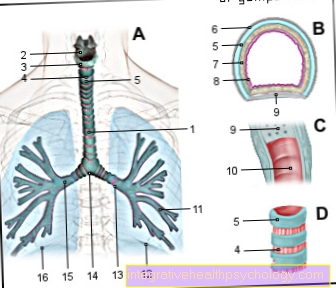Lactate levels
introduction

Lactate is the name given to salts and esters of lactic acid, which is mainly formed as sodium lactate in the skeletal muscles. Lactate accumulates in the muscles through exercise. In a process of glycolysis, glucose or glycogen is reduced to pyruvate. Depending on how high the load is, the pyruvate cannot be removed from the muscles quickly enough and continues to build up. This value of the accumulation of pyruvate and lactic acid in the blood and muscles is called the lactate value.
The lactate level can be detected and determined by a simple blood test. The advantage is that you can measure the lactate value at rest but also during exercise on the bicycle ergometer or similar. The lactate value says a lot about a person's performance, especially about their aerobic and anaerobic endurance capacity.
Lower lactate levels
In order to lower the lactate level in the blood during training one should always enough liquid have with you and also drink regularly. Lactic acid is water-soluble and the effect of lactic acid can be positively influenced by drinking enough fluids. You should also try to breathe deeply and calmly, even if this is not always possible during training. Lactate is created in the first place because the body cannot deliver the oxygen it needs quickly enough. A controlled breathing can improve the lactate value by a few percent because the oxygen can stop the production of lactic acid in muscles. Regular and frequent training can also make a contribution to the rapid breakdown or lower cultivation of lactate. The more trained the body, the less lactate is produced.
In addition, you should make sure that as soon as you feel a burning sensation, the training intensity is reduced. If the muscles are on fire, a considerable amount of lactate has already formed. If the intensity is then reduced, the lactate is slowly broken down. After training it still offers itself a few minutes relaxed to expireto give the body the chance to focus on the regeneration prepare. When you run out, the body begins to lower the lactate level and break down lactic acid. In addition, you can do a little 30 to 60 minutes after the end of the training Stretching or stretch carry out. Stretching helps break down lactic acid and relieve the burning sensation in the muscles. The better the transition from training to recovery, the faster the body can break down the lactate and regenerate.
Lactate levels too high
Of the Resting value of lactate in our blood is between 1.0 mmol / l and 1.8 mmol / l. Up to a level of 2 mmol / l one goes in from one aerobic energy supply out. In addition, the metabolism is slowly switched to anaerobic. From this point on, more lactate is built up than can be broken down. At the anaerobic threshold which at approx. 4 mmol / l If the body is lying down, the lactate can no longer break down quickly enough and it continues to accumulate. This anaerobic threshold (ANS) also depends on the physical condition from and also from Nutritional behavior. If the load becomes more intense, then the lactate value continues to rise. Come in athlete to its physical performance limit, then the lactate value can go up to over 20 mmol / l increase.
It also happens in the body that the lactate level rises even though one has not been active at all. This phenomenon is called Lactic acidosis or lactic acidosis and describes the Drop in pH in the blood from an accumulation of lactate (lactic acid). Lactic acidosis is going through nausea and Vomit noticeable and is often not recognized directly by a doctor. Symptoms like stomach pain, no appetite and fatigue can also indicate many other clinical pictures, which is why lactic acidosis is not always recognized. However, the disease is also very rare and only a few patients are reported with the disease each year. A clear sign by which every doctor should be able to tell unequivocally that it is lactic acidosis is a too low pH in combination with a increased lactate level. The chronic increase in lactate can be implicated by several factors. Taking medication, Renal dysfunction, Blood poisoning or one Hepatic insufficiency can be the cause of lactic acidosis. Lactic acidosis will come with either one Bicarbonatet or one Blood washing treated and in most cases can be cured.
The lactate level in the blood
The lactate level in the blood says something about the entire body, because the lactate from all skeletal muscles ends up in the blood. The lactate value in the blood is therefore an addition of all partial lactate values of the individual muscles in the body. The muscles release the lactate into the bloodstream and there it then meets lactate from other muscle groups. With very high endurance loads In the anaerobic area (1000m run or 400m run), blood lactate values of up to 35 mmol / l occur.





























